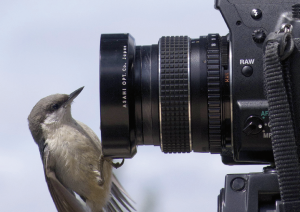WEDNESDAY, 3 OCTOBER 2012
In 1981 it turned out that it didn’t take a lot to make a really great science film. The team behind the BBC’s Horizon took a gamble and found that one person sitting in chair, talking candidly to an off-camera interviewer, could produce one of the finest pieces of television about science. It helped that the interviewee was Nobel Prize winner and world-class raconteur Richard Feynman, an extraordinary lecturer who knew how to communicate to non-scientists. But the fact that his opening monologue has been watched around 200,000 times on Youtube says a lot for the role television can play in popularizing science.As a zoologist, I’m drawn to Natural History reportage, a historically softer form of science documentary, but one of western society’s most important sources of information about the natural world.
The genre has altered significantly over the years, as clearly demonstrated by the work of David Attenborough. In 1984, his series The Living Planet consisted of hour-long lectures whilst the Natural History Unit’s footage acted as a slideshow for him to talk over. When Bluesci was first published, the most expensive science documentary ever made, the cinematic Planet Earth, was still two years away from being broadcast, and today Attenborough is, generally, a presenter of beauty, no longer a writer of explanations.
Recently, film makers are moving away from Attenborough’s traditional style of film making, highlighting how used to the documentary “formula” we’ve all become. Green, an extended portrait of a dying female orang-utan and the overall winner of the 2010 Wildscreen awards, is an independently produced, free to download feature, created by an ‘ordinary citizen trying to protect the rainforest’. In introducing concepts such as deforestation and palm oil production whilst dispensing with narration, the film succeeds in posing questions, not answering them. Rather than explaining a concept to the audience, it asks them to consider the implications of an action. In a way, it asks them to think - to be scientific, rather than acting as a visual anchor for hand-holding narration.
While Green might be an indication of just where long-form science documentary making is heading, thanks to the Internet, scientific documentary making as a whole seems to be moving in another direction.
Short visual-heavy infographic films are giving difficult to understand science topics a helping hand. Take for instance the eight minute long animation on the Higgs Boson by Jorge Cham, the creator of the Piled Higher and Deeper comics or the number-heavy issues surrounding fishing quotas which become obvious (and appalling) to anyone watching the thirteen computer generated jumbo-jets flying into a single trawling net in Uli Henrik Streckenback’s animated infographic Ending Overfishing.
In the future I’m foreseeing a schism in science documentary making between mediums, with more poetic representations of reality on one hand, and the fact-heavy five to ten minute long infographics pervading Vimeo and YouTube on the other. The latter are what we’re linking to on our blogs and retweeting, from Wired and BlueSci.co.uk: it’s already happening. Whether we’re bound to carry on down this route, I’m not sure.
Nick Crumpton is a PhD student in the Department of Zoology. He is currently co-editor of BlueSci Films.
BlueSci Film produces short films explaining new scientific discoveries and advances, as well as showcasing some of Cambridge’s brightest and best science researchers and communicators.
Our films can be found at bluesci.co.uk or at the BlueSciFilm youtube channel. If you are interested in getting involved with film making, or if you have an idea for a film, contact the Film Editors Nick Crumpton & Alexandra Fragniere at film@bluesci.co.uk

